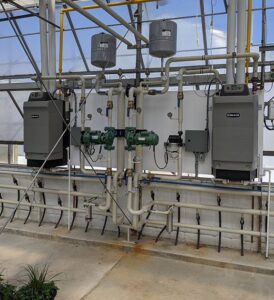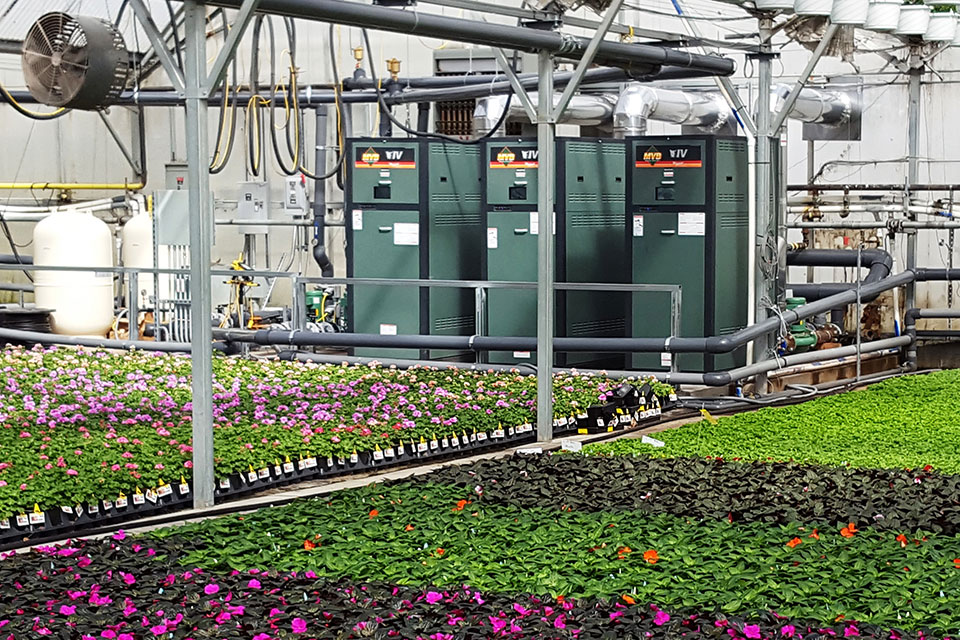Greenhouse Growers Seek Higher Efficiency in Boilers

These small, wall-hung condensing boilers are from Westbrook. Photo: Westbrook Systems
In the last 15 years, there have been sweeping changes to boiler systems for greenhouses. When you think of a boiler, you may picture a large piece of equipment that looks similar to a locomotive, mostly made of steel and cast iron. This design evolved from the Industrial Revolution, and has stuck around for a long time.
Those types of boilers still exist and work well for many operations. However, a new, emerging trend is modular condensing boilers, also known as modcon. Jim Rearden, CEO of BioTherm, says many innovative companies are producing low-mass boilers, having replaced the steel and cast iron with noble metals, such as copper, stainless steel, and aluminum.
“Companies have created solutions that look more like a file cabinet,” Rearden says. “Now growers have this opportunity to buy equipment that is much more efficient.”
Condensing Boilers Offer Higher Efficiency
Jack Smit, Heating Technologist for Westbrook Systems, says condensing boilers are trending for growers looking to gain efficiencies. In the past, all boilers were non-condensing, meaning that since they run at a higher temperature, they cannot condense the flue gas. If boilers keep the temperature of the flue gases high enough, the moisture, and therefore the BTUs in it, go out the stack. However, if they allow for cooling of the gases to a low enough temperature, growers can recover heat from the act of condensation, allowing the boiler package to be more efficient.
“A non-condensing boiler typically can be 80% to 83% efficient as a max. You can go a little higher, but you run the risk of condensing in your boiler and most boilers aren’t built to take that condensation. It’s slightly acidic and will corrode,” Smit says. “If you get into condensing equipment, you want that moisture to come out of the flue gas. You want to recover the heat in there and utilize that heat in your system. Now you’re up to 95% or 96% stack efficiency.”
The bigger savings is typically seen in the fact that the standby losses and system operating temperatures drop, he says. The boiler room is no longer that hot space that growers don’t want to walk into, and the system runs cooler. This is an improved system efficiency.
Rearden says condensing boilers have several benefits in addition to the increased efficiency rate. For example, there is less pollution from the equipment. Older boilers create smog, also called NOx (oxides of nitrates). Condensing boilers have a low NOx because they use a more environmentally-friendly and sustainable process.
“Since these boilers are reactive and they have replaced all the water volume with good metals and good burner technologies, they’re considered on-demand boilers,” Rearden says. “If the greenhouse doesn’t need heat, then the boiler isn’t running.”
Rearden says conventional boilers cannot withstand starting and stopping, so they are turned on for the entire season. Condensing boilers do not turn on if the temperature is warm, thus reducing operational expenses for growers.
“The two highest expenses that growers encounter in operating a greenhouse are labor and utilities/fuel,” Rearden says of how to reduce operational expenses. “If they have an existing system that uses hot water, they should consider moving away from the older, low efficiency boilers to this newer technology. There are a lot of return-on-investment opportunities for them. Growers can save 15% to 50% depending on what their existing system is if they’re considering changing from one boiler source to one of the modern ones.”
He notes that condensing boilers can only operate on gaseous fuel, so growers must have natural gas or propane available. Growers can also capture clean water and CO2 from condensing boilers, which can be reused during the crop cycle to help grow the plants.

BioTherm’s modern condensing boilers are compact. Above are three 3 million BTU/hour units at Dallas Johnson Greenhouses. Photo: BioTherm Hydronic Inc.
Pitfalls to Avoid
Smit says the No. 1 mistake that growers make with boilers is buying new equipment without matching it to their existing system. If the boiler does not match the operation’s existing equipment, the boiler will not work as efficiently as it could.
He says annual maintenance checks are essential for any boiler, but especially condensing boilers, in which soft water is a key factor.
“Since a hot water system is a closed loop, once you have clean, treated water and the free oxygen is out of the system, your water is like liquid gold,” Smit says of the importance of maintenance. “You want to minimize any new water input.”
With their focus on growing high-quality plants, growers often forget that leaks in the boiler equipment or pumps and valves should be fixed. Those issues need to be repaired as soon as possible to minimize long-term effects and maintain optimized operations.
Mike Muchow, Vice President and Project Director at BioTherm, says every boiler must have a good mechanical design. The design must fit requirements from the manufacturer and requirements for ventilation and gas. Rearden says boilers must have a proper control system. Since newer equipment can turn on and off as the weather changes, there must be an advanced environmental control system.
“The climate control system they have in-house might need to be enhanced to enable the boiler equipment to run when there’s a call for heat,” Rearden says. “There’s integration with the controls, gas, venting, and the electrical system.”
Looking toward the future, Rearden says some municipalities, especially in California and Washington state, may ban combustible fuel, forcing growers to move toward electrification. Manufacturers are looking into boilers that aren’t really boilers, but operate more like a heat pump and use electricity to heat the water.
“It’s really important to have a heating delivery system installed in the greenhouse that can work with lower supply water temperatures. Those newer electrified heat sources don’t make very warm water,” Rearden says of future needs in greenhouse heating. “That’s a big consideration for future-proofing a facility in a region that might eventually be required to not burn fuels.”









